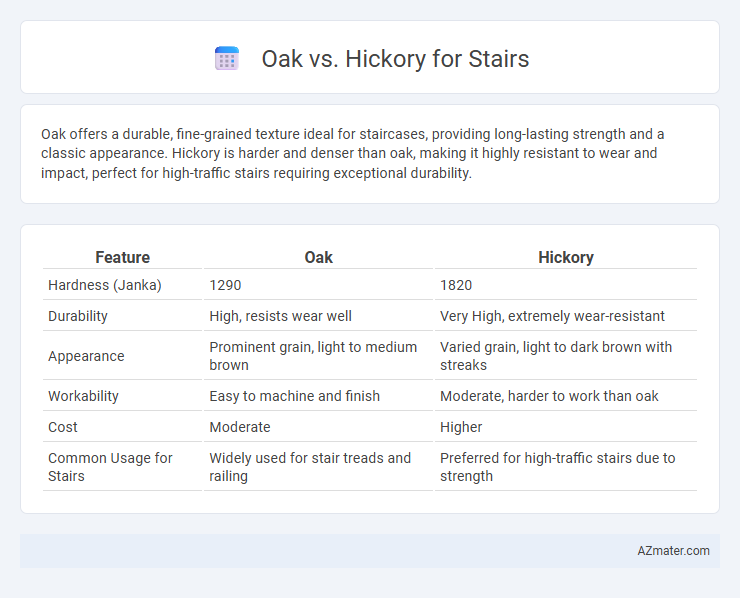Oak offers a durable, fine-grained texture ideal for staircases, providing long-lasting strength and a classic appearance. Hickory is harder and denser than oak, making it highly resistant to wear and impact, perfect for high-traffic stairs requiring exceptional durability.
Table of Comparison
| Feature | Oak | Hickory |
|---|---|---|
| Hardness (Janka) | 1290 | 1820 |
| Durability | High, resists wear well | Very High, extremely wear-resistant |
| Appearance | Prominent grain, light to medium brown | Varied grain, light to dark brown with streaks |
| Workability | Easy to machine and finish | Moderate, harder to work than oak |
| Cost | Moderate | Higher |
| Common Usage for Stairs | Widely used for stair treads and railing | Preferred for high-traffic stairs due to strength |
Introduction to Oak and Hickory Stair Materials
Oak stair materials are renowned for their exceptional durability, showcasing a dense grain structure that resists wear and provides a classic, warm aesthetic ideal for both traditional and modern interiors. Hickory stairs stand out for their remarkable hardness and unique grain patterns, offering high resistance to dents and scratches while delivering a rustic yet elegant appearance. Both wood types are popular choices in stair construction due to their strength, longevity, and ability to be finished in a variety of stains and textures to match diverse design preferences.
Visual Differences: Grain, Color, and Aesthetic Appeal
Oak staircases feature prominent, coarse grain patterns with an overall light to medium brown color that ranges from golden to reddish hues, providing a classic and warm aesthetic. Hickory stairs exhibit a more varied and dramatic grain with contrasting streaks, often displaying a mix of creamy white sapwood and darker heartwood tones, creating a rustic and dynamic visual impact. The natural color variation in hickory enhances its unique character, while oak offers consistent elegance and timeless appeal for stair designs.
Durability and Hardness: Which Wood Lasts Longer?
Oak offers exceptional durability with a Janka hardness rating around 1,290, making it highly resistant to dents and wear for stair use. Hickory surpasses oak in hardness, scoring approximately 1,820 on the Janka scale, resulting in superior resistance to impact and abrasion over time. For staircases subjected to heavy foot traffic, hickory typically lasts longer due to its increased hardness, though both woods provide durable, long-lasting options.
Maintenance Requirements for Oak and Hickory Stairs
Oak stairs require regular cleaning and periodic refinishing to maintain their durability and appearance, as their dense grain is moderately resistant to wear and moisture. Hickory stairs demand more frequent maintenance due to their natural hardness and tendency to develop small cracks or splits, necessitating sealing to prevent moisture damage. Both require routine dusting and protection from excessive humidity to preserve structural integrity and aesthetic appeal.
Installation Considerations: Weight and Workability
Oak stairs are heavier and denser than hickory, requiring more effort during installation and stronger support structures to ensure stability. Hickory's lighter weight and greater workability make it easier to cut, shape, and install, reducing labor time and the risk of damage during handling. Choosing between oak and hickory for staircases depends on balancing structural requirements with installation efficiency and the skill level of the installers.
Cost Comparison: Oak vs Hickory Stairs
Oak stairs generally cost less than hickory due to the wider availability and faster growth rate of oak trees, making oak a budget-friendly option for stair construction. Hickory stairs tend to be pricier, reflecting the wood's density, durability, and slower growth, which increase harvesting and processing expenses. Cost differences can vary regionally, but oak remains the more economical choice for homeowners prioritizing affordability without sacrificing strength.
Environmental Impact and Sustainability
Oak and hickory differ significantly in environmental impact and sustainability when used for stairs. Oak, often sourced from sustainably managed forests, has a faster growth rate and higher carbon sequestration capacity, making it a more eco-friendly option. Hickory, while extremely durable, grows slower and is less commonly certified by sustainable forestry programs, potentially leading to greater environmental strain.
Finishing Options and Stain Compatibility
Oak offers a wide range of finishing options due to its open grain, allowing stains to penetrate deeply and enhance its natural grain patterns, making it compatible with various stain colors from light to dark. Hickory's dense and variable grain requires careful preparation and selection of finishes to avoid blotchiness, often benefiting from pre-stain conditioners and gel stains that provide more even coverage. Both woods are durable for stairs, but oak's consistent grain makes it more versatile with stain compatibility, while hickory showcases a distinctive rustic appearance when finished properly.
Best Use Cases: Residential vs Commercial Applications
Oak is highly durable and resistant to wear, making it ideal for residential stairs that require a balance of aesthetics and strength, especially in high-traffic family homes. Hickory offers superior hardness and impact resistance, suitable for commercial applications where stairs endure heavy daily use and potential equipment loading. Both woods provide excellent structural integrity, but oak's grain and finish appeal more to residential interior designs, while hickory's toughness withstands the demands of commercial environments.
Final Verdict: Choosing Between Oak and Hickory for Stairs
Oak offers a classic, durable option with a tight grain pattern that resists wear, making it ideal for high-traffic stairs. Hickory stands out with its superior hardness and unique color variations, providing both strength and distinctive aesthetic appeal. For long-term durability combined with elegant appearance, hickory is preferred for stairs that endure heavy use, while oak suits those seeking a traditional, versatile finish.

Infographic: Oak vs Hickory for Stair
 azmater.com
azmater.com